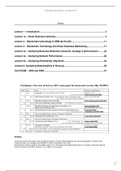Smart Business Networks – Summary 2019
Index
Lecture 1 - Introduction ...................................................................................................... 2
Lecture 1a – Smart Business networks ............................................................................. 4
Lecture 2 – Blockchain technology in SBN (de Kruijff) ...................................................11
Lecture 3 – Blockchain Technology and Smart Business Networking...........................17
Lecture 3a – Analyzing Business Networks (structure, strategy & performance) .........22
Lecture 4a – Analyzing Network Performance .................................................................26
Lecture 5a – Analyzing (Extendend) Alignment ...............................................................33
Lecture 6: Analyzing Networkability & Wrap up ...............................................................38
OLD EXAM – 2005 and 2009 ..............................................................................................41
Grading
Your final score for the course is the average of scores (i) and (ii) (40/60 weighted; see course description), rounded to the
nearest 0.5 point (an average score between 5 and 6 is rounded to 5.0 or 6.0)
Note that the minimum grade for the written exam is 4.5. This means that students that score 4.4 or lower on the exam will not
pass this course, even with a result of 7.0, or higher, for the paper.
1
, Smart Business Networks – Summary 2019
Lecture 1 - Introduction
dsd
Part 1: Business Networking – What is IT in 2019?
The ancient NEFETI framework is the structure for the course (Networked Enterprises of the Future Enabled by Telematics
Infrastructure)
What is Business Networking? - Osterle, Alt & Fleish 2001
Business Networking is the new economy that can be seen as the coordination of processes within and across companies.
More precisely, we define Business Networking as the management of IT-enabled relationships between internal and external
business partners.
So far, there has been no clear vision of the business units and processes nor of the coordination mechanisms that Business
Networking has in store for the economy. Disintegration, specialization, reintegration, centralization, etc. are certainly among the
current trends that present a growing challenge for business management and science.
“They are smart when they outperform other firms.”
What is ‘smart business network’ according Van Heck & Vervest 2007 (! See below for more)
A smart business network outperforms other firms and networks using IT enabled networks (information and communication
technologies).
Enterprise Service Bus = the conceptualization of what firms share in order to do electronic data exchange.
E.g. when ABN AMRO does a money transaction to ING.
How does a business bus enable redesign of client services, provided by a business network?
Part 2: Examples of (Smart) Business Networks
The diagrams shown in the sheets are a combination of Business Networking Structures and Business Network Functioning.
1. DoubleClick – Advertising network
Network Member Firms is where the money is earned. Firms compare cookie information by putting out an app.
2. Xgratis.nl – Affiliate marketing
Xgratis.nl uses a trade tracker named Diasycon to track consumers. The goal is to get as much as possible traffic.
Challenge: There is limited space here, you can’t list all free stuff.
2
, Smart Business Networks – Summary 2019
3. Cirqle – Influencer marketing
Cirqle obtains their data from ‘influencers’ on Instagram. Advertising companies are interested in that data since they want to
reach a specific target group who for example follow an ‘influencer’. It was possible to write a code to get into the Instagram
database, this is what Cirqle did and got their data from. This however is illegal use of data because you have extracted illegally
obtained personal data and they have sold them to advertisers. Instagram shut down the Cirqle account.
What is a Business Network?
A business network is a set of more than two firms that provides services to customers and uses services from suppliers to
operate as one firm that is owned by different owners and controlled by different ‘operators’/management teams.
Part 3: Course focus, research model & course objectives
There are two levels of analysis in this course
• FIRM level (Straub et al., firm > dyad > network)
- Investing in IT to connect internal and external processes
- Application portfolio
- Networkability of the firm
- Firm performance
• NETWORK level (Provan et al., 2007, whole networks)
- Investing in IT to connect internal and external processes
- Business bus to connect firms in the network
- Networkability (connectability) of the network
- Network performance
3
, Smart Business Networks – Summary 2019
Lecture 1a – Smart Business networks
dsd
Part 1: Smart Business Networks: How the network wins (van Heck and Vervest, CACM 2007) (!)
What is a Smart Network? (!)
A network that wins (outperforms) from companies. Being smart is the new business network approach, this includes
1. Provide complex services
2. Demand driven networks
3. Distributed control
4. Sharing of Information & IT infrastructure (between firms/network/customer)
Organizations must move from a stable and slow-moving business network to an open digital platform where business is
conducted across a rapidly formed network with anyone, anywhere, anytime despite different business processes and computer
systems.
Characteristics of traditional and new business network approaches
Table 1 shows that the traditional approach has more associated costs that are caused by the inability to provide relatively
complex, bundled, and quickly delivered products and services. The potential of the new approach is to create these types of
products and services with the help of combining business network insights with telecommunication capabilities.
How does the degree of ‘networkability’ relate (or does not relate) to the degree of ‘smartness of a business network’?
Smartness means the network of cooperating businesses can create better results than other, less smart, business networks or
other forms of business arrangement. To be smart in business is to be smarter than the competitors just as an athlete who is
considered fast means faster than the other competitors.
What is networkability?
Networkability is the internal and external ability to cooperate as well as the ability to rapidly and efficiently establish, conduct
and develop IT-supported business relationships.
The networkability leads to substantial business advantages. Where complex, bundled and quickly delivered products are
provided with the help of combining business network insights with telecommunication capabilities.
→ Network structure influences, network functioning, and finally Network Performance.
4




